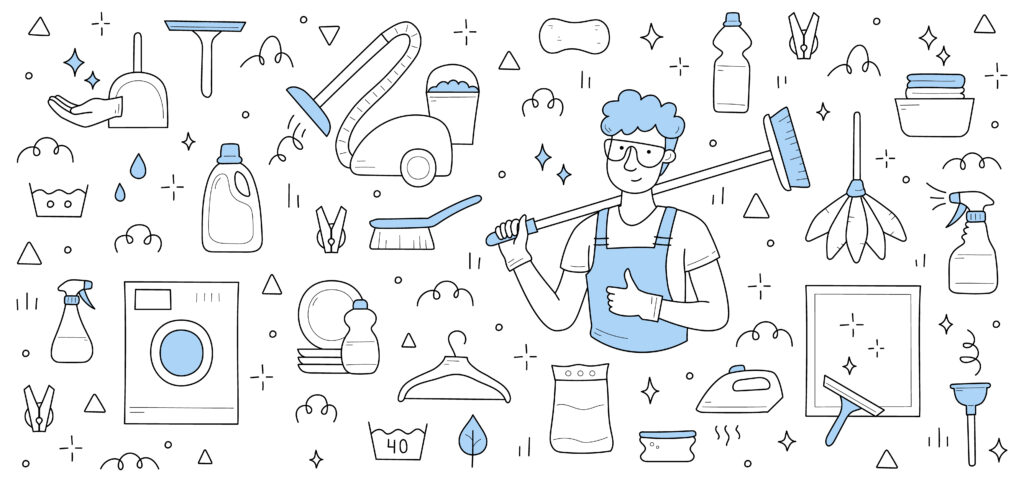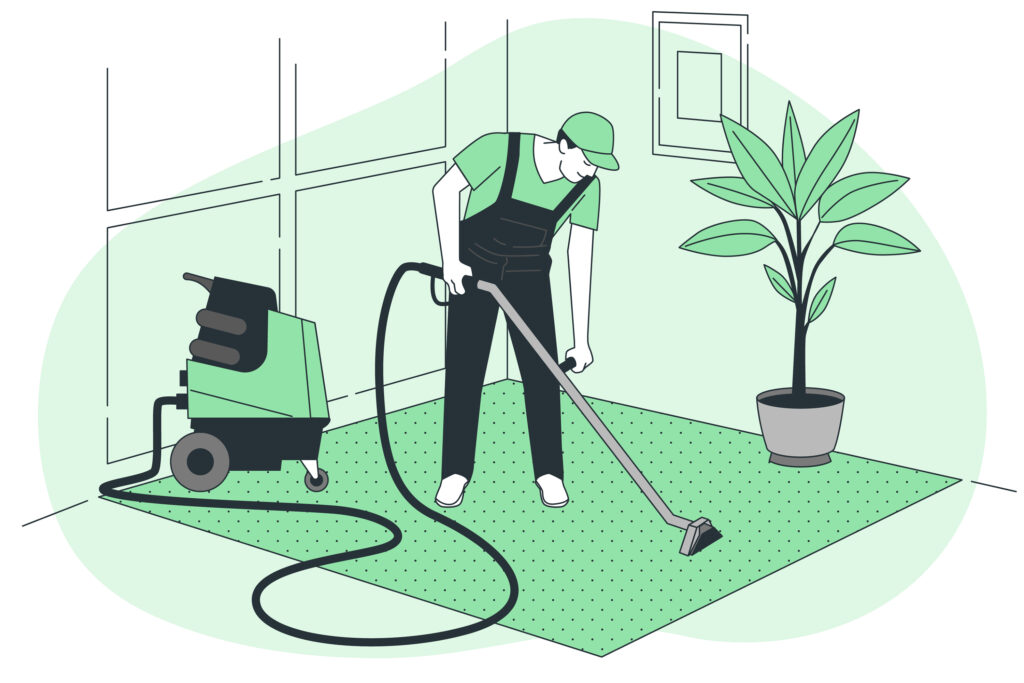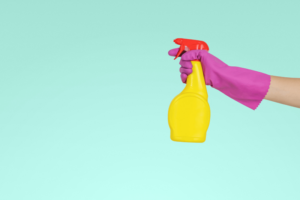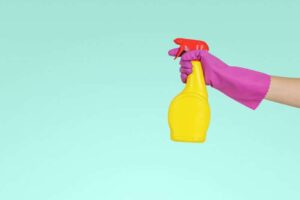Deciding on your commercial cleaning prices is a strategic business decision that impacts your profitability, how competitive you are, and your long-term viability.
Setting the right prices for your commercial cleaning services ensures you can cover all costs, pay employees, and invest in quality supplies and equipment.
Still, there are several factors that come into play when determining the prices. Understanding these factors and how they interconnect is crucial for any business in this industry.
If you want to find out how to price an office cleaning job, commercial cleaning rates per square foot, and how to form your own commercial cleaning service prices, keep reading!
Factors That Can Help You Set Your Commercial Cleaning Service Prices
Space requirements
Let’s begin with the size of the total area that needs to be cleaned, which is a key factor in deciding the prices.
Generally speaking, larger spaces usually require more time, materials, and labor, all of which increase the overall cost. That’s why pricing models are often determined by the square footage. It’s the simplest way to gauge the workload and set a rate that matches the size of the space.
Service requirements
In addition, different types of cleanings may have different costs.
Services such as vacuuming, dusting, and mopping are usually less expensive than deep cleaning or specialized services. For example, sterilization takes more equipment and steps, so it should cost more.
Specialized services, such as carpet shampooing and extraction, terrazzo refreshing, or floor waxing, are usually priced additionally.
These services require special equipment and more skilled labor, so you should charge them accordingly.
Business types
Commercial cleaning costs can vary depending on the type of business. Each place has its own special needs that affect the pricing.
For example, medical facilities have strict sanitation requirements, schools require deep cleaning and eco-friendly supplies that are safe for students and the facility, and retail spaces have their own set of demands.
Understanding how to price an office cleaning job also involves recognizing equally important requirements, such as managing daily waste disposal and maintaining a professional appearance. Each business needs a tailored approach to forming a price.
Frequency of cleaning
The frequency of cleaning can also affect your prices.
So, if you’re doing 3 to 5 cleanings per week for the same client, your costs should be lower compared to just doing a once-a-month clean. Having a consistent contract means you’ll have a steady workflow, which means a lower price per cleaning because it’s happening more regularly.
Operational and geographical influences
The cost of cleaning supplies and the location of the property also play a crucial role in determining your office cleaning prices.
If you use high-quality or specialized tools along with standard cleaning supplies and equipment, the overall price will significantly increase.
Similarly, the geographical location of the property will affect labor and operational costs due to varying local wage standards.
Labor and market dynamics
Fair wages, comprehensive benefits packages, labor costs, and other employee benefits directly influence your commercial cleaning services rates.
You should ensure that staff are paid properly, which will affect the overall service price.
Also, look at competitor prices and industry standards if you want to stay competitive. Balance the pricing strategies with the marketing norms to ensure your services are both appealing and economically viable.
Allow your business to be profitable, without undercharging or pricing yourself out of the market.

Image by upklyak on Freepik
Methods to Help You Decide How Much to Charge for Office Cleaning
Hourly, square footage, and flat-rates
Hourly rates, square footage rates, and flat-rate pricing are usual options in commercial cleaning rates.
Hourly rates are ideal for small businesses and specialty cleaning tasks, as well as for jobs where the scope of work is unpredictable. This allows you to bill based on the actual time spent on the job, ensuring you are fairly paid.
A square footage rate is a straightforward approach and is suitable for greater, regular cleanings. For larger buildings, cleaning companies often charge a lower rate per square foot, even though the total cost is higher. This approach is best for medical facilities, commercial spaces, institutions, and other large spaces.
Flat-rate is perfect for standard and recurring tasks where requirements are unlikely to change. It’s best for deep cleaning, specialty cleaning, or one-time cleaning.
Contract and performance-based pricing
If you want to take a strategic approach, with contract pricing you can enable long-term engagements. Signing a contract for a set number of visits usually lowers prices, and provides stability for both the service provider and the client. Check out cleaning service agreement templates to ensure your contract covers all essential details.
Performance-based pricing is all about the direct outcomes and quality of the service provided. With this model, you should ensure the clients receive top-tier service. Pricing is based on the quality of the service delivered. This way clients can clearly see the value they get for their money.
Bundled service pricing and custom pricing
By offering bundled pricing, you can combine various cleaning services at a reduced rate compared to purchasing each one separately.
Custom pricing goes a step further. You can offer tailored pricing to the specific needs and preferences of each client.
These two methods are more personalized and you can offer multiple cleaning services together at a discount rate.

Average Commercial Cleaning Service Rates
You have to take into account all the factors that we have already discussed when determining the prices for your commercial cleaning services.
The national hourly rate average is around $39. The commercial cleaning rates per hour range from $25 to $100 per cleaner.
Pricing per square foot can vary depending on the complexity of the cleaning tasks, if the space is open, if the office has cubicles, the number of kitchens and bathrooms, etc. Commercial cleaning rates per square foot generally range from $0.10 to $0.25 per square foot. The average cost of a 1000 square feet space is $120. For larger warehouses or offices that are 9,000-10,000 feet, the average price is $880.
For additional special services like floor waxing and carpet cleaning, their own prices are added.
Floor stripping and waxing might cost between $0.29 to $0.60 per square foot, and carpet shampooing might range from $0.08 to $0.20 per square foot.
| Service Type | Average Cost Per Hour | Average Cost Per Square Foot | Additional Notes |
| General Cleaning | $25 - $100 | $0.10 - $0.25 | Rates can vary significantly based on location and type of cleaning required. The national average is around $39 per hour. |
| Floor Stripping and Waxing | - | $0.29 - $0.60 | These are specialized services that usually have a set rate per square foot due to the labor and materials involved. |
| Carpet Shampooing | - | $0.08 - $0.20 | Like floor waxing, carpet cleaning is typically charged per square foot and depends on the type of cleaning needed. |
How to Calculate Commercial Cleaning Prices
When calculating prices for your commercial cleaning services, the first thing to do is to take all job details into account.
The best strategy is to perform a walk-through of the space, take measurements, and see what kind of space you are dealing with.
Consider the following:
- Space (total square footage)
- Layout (open spaces, hallways, stairs)
- Number of offices, restrooms, kitchens
- Types of services
- Frequency of cleaning
- Special requests (floor waxing, window cleaning, etc)
Calculate labor costs
The next thing you should do is estimate labor costs.
Determine how much it takes for one cleaner to finish a task or clean a specific number of square feet. This way, you will evaluate the workload and determine the number of cleaners needed to complete the job.
Also, consider the skill level required, as more specialized tasks such as handling hazardous materials or cleaning high-end equipment may necessitate a higher wage rate.
Let’s say you charge $0.15 per square foot, and the office is a 1,500-square-foot area. In this case, your base cleaning cost will be 1,500 sq ft × $0.15 = $225.
Labor costs for two cleaners for 1 hour at $25/hour each would be:
2 employees × 1 hr × $25/hr = $50 labor costs
Also, take into account payroll taxes and workers’ compensation insurance, which are typically between 15-25% of employee wages.
$50 × 0.25 = $12.5 employee expenses
$50 + $12.5 = $62.5 total labor costs
Include overhead expenses
Overhead expenses include all indirect costs of operating your business, such as vehicles, utilities, business insurance, mortgage payments, or rent, among others. For accurate calculations, you can add expenses during a specific period, and divide that number by the sales in the same time period.
Estimate profit margin
You need to add a profit margin on top of the labor and overhead costs, to ensure your cleaning business is profitable.
Margin typically ranges from 10% to 28%, though it may vary depending on the industry standards, client types, and competitive landscape.
Try out a commercial cleaning calculator for accurate pricing estimates.
Adjust for market conditions
Market conditions can significantly affect your pricing strategy.
Local economic conditions, client budgets, and the level of competition can all require you to adjust your pricing strategy. Keeping an eye on competitors' prices and your clients’ feedback can help you line your pricing with market expectations. Find out how to ask a client for a review!
Streamlining Your Payment Processes with Trafft
A software solution that takes care of your payments, finances, and taxes, while streamlining your entire booking process - is Trafft.
Apart from a seamless booking experience via a dedicated booking page, Trafft is designed to streamline payment processes for service-oriented businesses, including commercial cleaning companies.
Trafft offers an all-in-one payment system, allowing you to easily send invoices and receive online payments, which can help reduce delays and improve your cash flow. Furthermore, Trafft integrates with popular payment gateways such as PayPal, Stripe, Mollie, and Authorize.net, providing your clients with the flexibility to pay using their preferred payment method.
The platform also offers automated email reminders and confirmations, which can significantly reduce the administrative burden, and also ensure clients are always aware of upcoming cleanings.
You can include taxes in the booking process, allow recurring services, and offer special additional services to your clients.
All of this in one place with just one software solution!
How to Price Your Commercial Cleaning Business: Additional Considerations
When setting your commercial cleaning costs, you need to consider several additional factors to ensure a thorough and competitive offering:
- Insurance costs - Insurance is important to cover potential liabilities and property damage that might occur during the cleaning process. It protects both clients and your business, so you should include the cost of insurance in the pricing model.
- Specialized cleaning services - Hazardous material disposal, medical facility cleaning, or high-grade sanitation often costs more because it requires skilled labor, advanced equipment, and sometimes certifications.
- Value-added services - Eco-friendly cleaning options or custom cleaning plans can enhance your appeal to potential clients. These services can differentiate you from competitors, but they also involve additional costs which should be considered. Value-added services can justify higher costs, but exceeding standard expectations is even better.
- Customer relationship and loyalty - Building customer relationships can lead to more stable revenue through recurring operations. You can include loyalty discounts or tailored pricing packages for long-term contracts. This can be a deciding factor for clients when choosing between competing services.
Bonus Tips for Setting Competitive Cleaning Services Prices
For your commercial cleaning business to flourish, you need to set profitable prices. Keep in mind the following:
- Understand your costs - You need to know all your costs, including labor, equipment, supplies, insurance, and overhead. This way you will cover all expenses and have room for profit.
- Know your market - Research the market and local competitors to understand their pricing and services, and learn how to advertise your cleaning business. This can help you position your pricing competitively.
- Offer different pricing structures - By offering different pricing models, such as hourly rates, flat fees, or per square footage you can appeal to a wider range of clients that have different needs and budgets.
- Leverage technology - Using booking software such as Trafft can streamline operations and position you in the market as a cleaning business that makes no mistakes in the booking or payment processes.
Take Into Account All Factors and Set Competitive Commercial Cleaning Costs
Throughout this guide, we’ve explored various factors that influence commercial cleaning service rates. Each of these elements plays a crucial role in forming a comprehensive pricing strategy, helping you understand how to run a successful cleaning business.
By implementing and understanding all of these strategies, you can set costs that are competitive, but also allow your business to thrive and grow.
Don’t forget to check out all of Trafft’s features, and elevate your business to a whole new level!
Commercial Cleaning Prices FAQ
How are commercial cleaning costs calculated?
The costs for commercial cleaning are calculated based on factors such as the size of the area, the type of cleaning, frequency of cleaning, labor costs, and any special requirements. Rates could be established by the hour, square footage, or as a flat fee.
How to calculate profit margin?
To calculate the profit margin for a commercial cleaning job, subtract all the costs associated with delivering the service (including labor, supplies, transportation, and overhead) from the total income earned from the job. Divide this result by the total income, and multiply by 100 to get the profit margin percentage.
How many square feet can you clean in an hour?
The square footage a single person can clean varies depending on the cleaning methods used, the type of services provided, and the specific task performed. A cleaner can usually handle 2,000 to 3,000 square feet of space in one hour for light cleaning. For more intensive cleaning, however, this may decrease to 1,000 to 1,500 square feet per hour.
How to price an office cleaning job?
The size of the office, the type of cleaning, how often it is cleaned, and any special requirements will all play a role in determining your office cleaning prices. You may choose to price your service according to the total square footage, hourly rates, or a flat fee per cleaning session. Also, keep in mind the local market rates while determining your prices.
How much should I charge for office cleaning a week?
This typically involves considering the total number of hours of work per week that will be required. This depends on the size of the office, the type of tasks, the number of kitchens, etc. Calculate the total hours needed, multiply by the hourly rate, and add any costs for supplies and equipment.
Looking for More Cleaning Business Resources?
For more tips and tricks on how to start, manage, and grow your cleaning business, check out the following articles:
- Cleaning Industry Statistics in 2024
- How to Get Clients for Your Cleaning Business
- How Profitable Is a Cleaning Business?
- Best Scheduling Software for Cleaning Business
- Grow Your Cleaning Business






